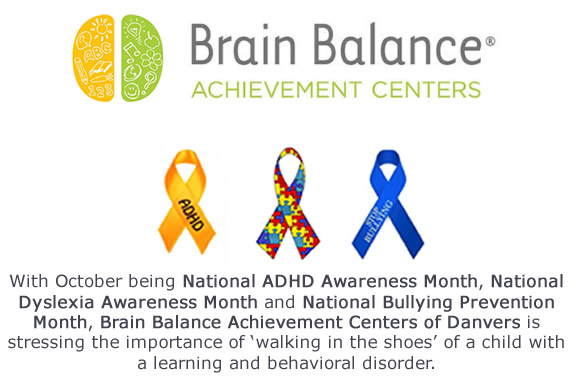
According to a 2008 study that was published in the journal Developmental Medicine & Child Neurology, children with ADHD symptoms are almost 10 times as likely as others to be regular targets of bullying that occurring in school.
With October being National ADHD Awareness Month, National Dyslexia Awareness Month and National Bullying Prevention Month, Brain Balance Achievement Centers of Danvers is stressing the importance of 'walking in the shoes' of a child with a learning and behavioral disorder.
To help children better understand learning and behavioral disorders and reduce the amount of bullying experienced during the school year, it is important that educators and parents have the right tools to talk with their children about these challenges and what it feels like to struggle with learning. These empathy activities serve as practical strategies that will promote both understanding and empathy in local communities.
The following are a few examples of empathy activities Brain Balance Achievement Centers of Danvers recommends that educators and parents can implement:
1) The Messy and Distracted Locker or Closet: Children with ADHD tend to be disorganized and often lose or forget their belongings. For teachers conducting an in-school empathy activity, they can pack a locker full of things (papers, various books, pencils, etc.) and provide the children with a list of items to find. To distract the children, the teacher can consistently ask questions. After the activity is complete the teacher can ask questions to help the students understand how it feels to have ADHD. This same activity can be conducted by parents at home using a cabinet or closer.
2) Through the Eyes of a Dyslexic Child: Educators and parents can show children a written sentence in which the letters in the words are flipped around. Showing a sentence to them this way is how a dyslexic child usually views a written sentence. Have the children attempt to read the sentence and then show them how it actually reads to demonstrate the challenge that dyslexic children face.
3) Listen with Your Eyes, Watch with Your Ears: Educators and parents can show children three separate movie clips at the same time with equal levels of volume. After a few minutes, ask three questions that pertain to the clips and ask them the same three questions as the first activity.
Call Dr. Janine Crifasi
Executive Director
Brain Balance Achievement Center
Call today 978-705-9570












